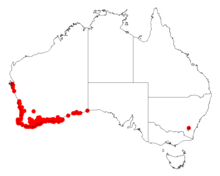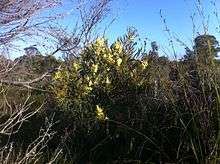Acacia cochlearis
Acacia cochlearis, commonly known as the rigid wattle,[1] is a shrub of the genus Acacia and the subgenus Plurinerves. It is native to an area along the coast from the Goldfields-Esperance to the Mid West regions of Western Australia.[2]
| Rigid wattle | |
|---|---|
 | |
| Scientific classification | |
| Kingdom: | Plantae |
| Clade: | Tracheophytes |
| Clade: | Angiosperms |
| Clade: | Eudicots |
| Clade: | Rosids |
| Order: | Fabales |
| Family: | Fabaceae |
| Clade: | Mimosoideae |
| Genus: | Acacia |
| Species: | A. cochlearis |
| Binomial name | |
| Acacia cochlearis | |
 | |
| Occurrence data from AVH | |



Description
The bushy erect pungent shrub typically grows to a height of 0.5 to 3 metres (2 to 10 ft) with branchlets that are ribbed, glabrous or sparsely appressed-puberulous with straight hairs. Stipules are present only on young fresh shoots. The trunk and branches have smooth green or brown bark. The leathery leaves[3] have phyllodes or are sessile, patent to ascending, inequilateral basally, subulate-linear, elliptic in shape and straight to recurved. They are mostly 2 to 5 centimetres (0.8 to 2.0 in) in length and 2 to 10 millimetres (0.08 to 0.39 in) wide.[4]
It blooms from July to October and produces yellow flowers. The inflorescences are simple with 1–3 per axil and peduncles which are 4 to 12 mm (0.16 to 0.47 in) long, Heads are globular with a 4 to 5 mm (0.16 to 0.20 in) diameter, containing 30-50-flowers that have a deep golden color.[4] The flowers are pollinated by many different species of insects. A moderate number of seeds will be produced during favourable seasons. The green-brown pod which forms later is a linear shape and is slightly raised over the seeds.[3] The pod is approximately 50 mm (2.0 in) long and contains between 10 and 15 of mostly viable black seeds.[5] The valves of the pod will recurve once the seed is shed, usually in December.[3]
Distribution and habitat
A. cochlearis grows in sandy soils and is found in coastal areas on sandplains and sand dunes.[2] It grows in coastal areas from Lancelin to Israelite Bay, where it is found growing as solitary plants or in dense thickets.[5]
Uses
The shrub is sold as a suitable medium size shrub for gardens in coastal regions or areas with sandy soils.[1][6] It is also used to stabilise dune or coastal areas. A. cochlearis establishes quickly and reliably in stabilised soils. Although it is must be protected from high winds it is utilised in mixed plantings with other species such as Acacia rostellifera and Scaevola crassifolia. It is an indicator of good quality dunes as the species is vulnerable to disturbance once established.[5]
Cultivation
A. cochlearis can be grown from seed. The seeds should be soaked in hot water or lightly abraded with fine sandpaper prior to planting. They should be sown in free draining soil and can benefit from the addition of disease-free soil from existing plants to transfer the Rhizobium bacteria that are important in nitrogen fixation.[5] Plants require a position in full sun.[1]
See also
References
- "Acacia cochlearis Fabaceae Rigid wattle". Geographe Community Landcare Nursery. Retrieved 1 August 2016.
- "Acacia cochlearis". FloraBase. Western Australian Government Department of Parks and Wildlife.
- "Acacia cochlearis Commonly: Rigid Wattle" (PDF). Peppy Plants. Retrieved 1 August 2016.
- "Acacia cochlearis (Labill.) H.L.Wendl., Comm. Acac. Aphyll. 3, 15 (1820)". World Wide Wattle. 12 July 2016. Retrieved 31 July 2016.
- "Acacia cochlearis Rigid Wattle (Labill.) H.L.Wendl" (PDF). Plants of the West Coast. Cambridge Coastcare. Retrieved 1 August 2016.
- "Acacia cochlearis". Apace WA. Archived from the original on 23 July 2016. Retrieved 1 August 2016.